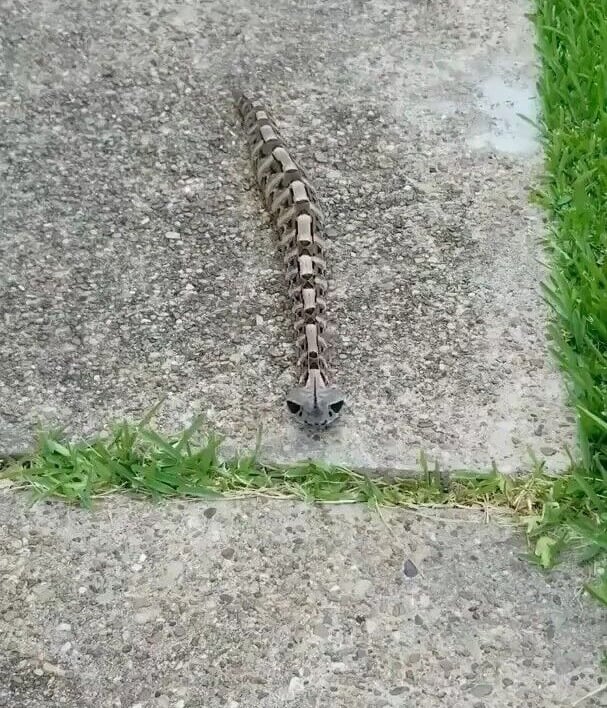I’ve always had a slight fear of snakes, but I’m fortunate to reside in an area where venomous ones are rare. Nevertheless, I find these creatures incredibly captivating, and there’s a mix of both fear and fascination when I occasionally delve into the realm of the world’s most dangerous reptiles.

In the depths of the African rainforests lies a true marvel of nature — the Gaboon Viper. This captivating serpent possesses a mesmerizing blend of cool camouflage, potent venom, and unparalleled hunting skills.
Today, we’ll explore this intriguing world of the Gaboon Viper, revealing the secrets behind its unique traits and its status as one of Africa’s most formidable predators.
The Gaboon Viper, also known as the Gaboon adder, stands as one of the largest and deadliest vipers on the African continent. Originating from the rich rainforests and dry savannas of Central and West Africa, this serpent’s vibrant and intricate camouflage allows it to be a true master of disguise.
They are only rivaled in size by the exceptionally large King Cobras, as the Gaboon Vipers can reach over 6 feet in length, weighing more than 20 pounds.

Even more chilling is the fact that this snake has the longest fangs of any venomous serpent, reaching up to an astonishing 2 inches. The Gaboon Viper boasts one of the snake world’s most efficient venom delivery systems.
Its venom, a powerful mix of enzymes and toxins, can cause severe tissue damage, resulting in excruciating pain and can be potentially fatal if left untreated.
With a large triangular head, it’s the snake’s elaborate skin patterns that truly capture the imagination. Its camouflage allows it to blend seamlessly into the forest floor’s leaf litter – making it nearly impossible to detect before it strikes.
The Gaboon Viper is a patient and strategic predator, ambushing its prey with incredible stealth. It feasts on fully grown rabbits, monkeys, and sometimes the small royal antelope. This voracious predator exhibits a remarkable ability to consume large prey.
Luckily, human encounters with this species are rare, due to its preference for remote habitats and generally passive nature. Most reported attacks on humans occur when someone accidentally steps on the snake.
In such regrettable instances, the consequences can be dire if anti-venom is not administered promptly. Notably, the viper can maintain its grip after a bite, allowing it to inject more venom into its victim.
Despite its natural habitat being restricted to Africa, some Americans have taken to keeping Gaboon Vipers as pets.
Because it’s the largest viper globally with such striking appearances, Gaboon Vipers attract snake enthusiasts looking for exotic pets. This decision has sometimes led to disastrous outcomes, as happened in Virginia in 2022.
Reports indicated that a man keeping the venomous snake as a pet was bitten. Emergency services were called, and the man was rushed to Richmond Hospital to receive urgent care.
Complicating the situation was the fact that the VCU Medical Center had depleted its anti-venom supply, originally provided by the Smithsonian National Zoo. Thankfully, the Virginia Aquarium and Marine Science Center in Virginia Beach provided an additional 35 bottles of anti-venom for treatment.
For Gaboon Viper owners, 2022 was a rough year. Just months before the incident in Virginia, another man in North Carolina had been bitten. He needed 44 vials of anti-venom and sadly lost several fingers.
The chances of encountering this venomous snake in the U.S. remain slim, although there have been occasional reports of Gaboon Vipers roaming free. In 2015, the Georgia Department of Natural Resources reported a possible sighting in Milledgeville, Georgia.
A riveting video in 2021 shared by The Reptile Report on social media, showing a Gaboon Viper on the street, captured public fascination. Its superb camouflage made it appear almost like a caterpillar!
The video drew widespread attention, and one can understand why – what an extraordinary creature!
The Gaboon Viper stands as a testament to the marvels of nature, demonstrating its remarkable ability to adapt and thrive in the African rainforests.
Appreciating the incredible elegance and power of such creatures enriches our understanding of the natural world.